Alexandre Cabanel
Alexandre Cabanel (French: [kabanɛl]; 28 September 1823 – 23 January 1889) was a French painter. He painted historical, classical and religious subjects in the academic style.[1] He was also well known as a portrait painter. According to Diccionario Enciclopedico Salvat, Cabanel is the best representative of L'art pompier, and was Napoleon III's preferred painter.[2]
Alexandre Cabanel | |
|---|---|
.jpg.webp) Self-Portrait, 1852, Musée Fabre | |
| Born | 28 September 1823 Montpellier, France |
| Died | 23 January 1889 (aged 65) Paris, France |
| Education | François-Édouard Picot |
| Known for | Painting |
| Notable work | Birth of Venus |
| Movement | Academicism |
| Awards | Prix de Rome |
| Signature | |
 | |
Biography
Cabanel entered the École des Beaux-Arts in Paris at the age of seventeen, and studied with François-Édouard Picot. He exhibited at the Paris Salon for the first time in 1844, and won the Prix de Rome scholarship in 1845 at the age of 22.[3] Cabanel was elected a member of the Institute in 1863. He was appointed professor at the École des Beaux-Arts in 1864 and taught there until his death.[4]
He was closely connected to the Paris Salon: "He was elected regularly to the Salon jury and his pupils could be counted by the hundred at the Salons. Through them, Cabanel did more than any other artist of his generation to form the character of belle époque French painting".[5] His refusal together with William-Adolphe Bouguereau to allow the impressionist painter Édouard Manet and many other painters to exhibit their work in the Salon of 1863 led to the establishment of the Salon des Refusés by the French government. Cabanel won the Grande Médaille d'Honneur at the Salons of 1865, 1867, and 1878.
A successful academic painter, his 1863 painting The Birth of Venus is one of the best-known examples of 19th-century academic painting. The picture was bought by the emperor Napoleon III; there is also a smaller replica (painted in 1875 for a banker, John Wolf) at the Metropolitan Museum of Art in New York City. It was given to them by Wolf in 1893. The composition embodies ideals of Academic art: mythological subject, graceful modeling, silky brushwork, and perfected form. This style was perennially popular with collectors, even as it was challenged by artists seeking a more personal interpretation of truth to nature, such as Courbet.
Pupils
.jpg.webp)
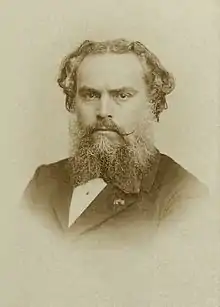

His pupils included:
- Rodolfo Amoedo
- Joseph Aubert
- Henry Bacon
- George Randolph Barse
- Alexandre Jean-Baptiste Brun
- Jean-Eugène Buland
- Jean-Joseph Benjamin-Constant
- Vlaho Bukovac
- Gaston Bussière
- Louis Capdevielle
- Eugène Carrière
- Eugène Chigot
- Jacqueline Comerre-Paton
- Fernand Cormon
- Pierre Auguste Cot
- Kenyon Cox
- Édouard Debat-Ponsan
- Gabriel-Charles Deneux
- Louis Deschamps (painter)
- Émile Friant
- François Guiguet
- Jules Bastien-Lepage
- François Flameng
- Charles Fouqueray
- Frank Fowler
- Henri Gervex
- Charles Lucien Léandre
- Max Leenhardt
- Henri Le Sidaner
- Aristide Maillol
- Édouard-Antoine Marsal
- João Marques de Oliveira
- Jan Monchablon
- Georges Moreau de Tours
- Henri-Georges Morisset
- Henri Pinta
- Henri Regnault
- Iakovos Rizos
- Louis Royer
- Jean-Jacques Scherrer
- António Silva Porto
- Edward Stott
- Joseph-Noël Sylvestre
- Solomon Joseph Solomon
- Paul Tavernier
- José Ferraz de Almeida Júnior
- Étienne Terrus
- Adolphe Willette
Selected works

- The Fallen Angel (L'ange déchu, 1847), Musée Fabre, Montpellier
- Aglaé and Boniface (Aglaé et Boniface, 1857), The Cleveland Museum of Art, Cleveland, Ohio USA
- The Birth of Venus (La naissance de Vénus, 1863), Musée d'Orsay, Paris
- Napoleon III (1865), Musée national du château de Compiègne, Écouen, France
- The Death of Francesca da Rimini and Paolo Malatesta (La mort de Francesca de Rimini et de Paolo Malatesta, 1870), Musée d'Orsay, Paris
- Portrait de la comtesse de Keller (1873), Musée d'Orsay, Paris
- Thamar (1875)
- Phèdre (1880), Musée Fabre, Montpellier
- Ruth glanant dans les champs de Booz (1886), Musée Garinet, Châlons-en-Champagne
- Portrait de Mary Victoria Leiter (1887), Kedleston Hall, England,[6]
- Cleopatra Testing Poisons on Condemned Prisoners (Cléopâtre essayant des poisons sur des condamnés à mort, 1887), Royal Museum of Fine Arts, Antwerp
Gallery
_crop.jpg.webp) The Fallen Angel (fragement)
The Fallen Angel (fragement) The Fallen Angel (1847)
The Fallen Angel (1847) Albaydé (1848)
Albaydé (1848) The Death of Moses (1850)
The Death of Moses (1850)_1860.JPG.webp) Nymph and Satyr (1860)
Nymph and Satyr (1860) Napoleon III (c. 1865)
Napoleon III (c. 1865).jpg.webp) The Expulsion of Adam and Eve from the Garden of Paradise (1867)
The Expulsion of Adam and Eve from the Garden of Paradise (1867)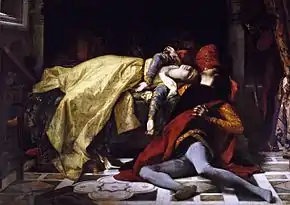 The death of Francesca da Rimini and Paolo Malatesta (1870)
The death of Francesca da Rimini and Paolo Malatesta (1870)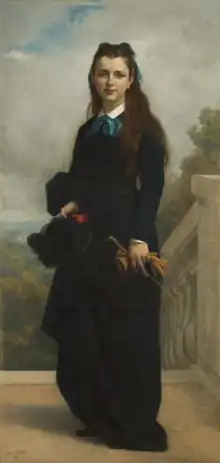 Portrait of Cornelia Lyman Warren (1871)
Portrait of Cornelia Lyman Warren (1871) Portrait of Countess Elizabeth Vorontsova-Dashkova (1873)
Portrait of Countess Elizabeth Vorontsova-Dashkova (1873)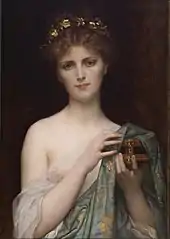 Pandora (1873), The Walters Art Museum
Pandora (1873), The Walters Art Museum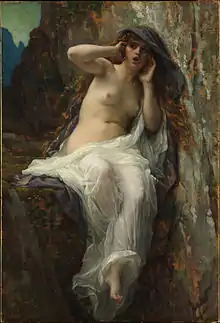 Echo (1874)
Echo (1874) Thamar (1875)
Thamar (1875) Harmonie (1877)
Harmonie (1877).JPG.webp) The daughter of Jephthah (1879)
The daughter of Jephthah (1879) Phaedra (1880)
Phaedra (1880)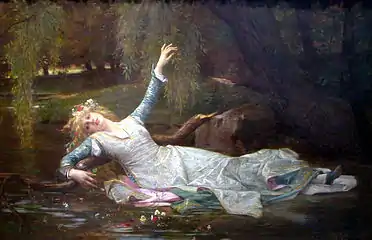 Ophelia (1883)
Ophelia (1883)
 The Mocking of Christ (1845)
The Mocking of Christ (1845)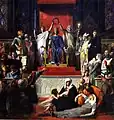 The Glorification of St. Louis (1853-1855)
The Glorification of St. Louis (1853-1855) Le Titan (1884)
Le Titan (1884)
References
- Kidd, Rebecca (2019). Alexandre Cabanel's St. Monica in a Landscape: A Departure from Iconographic Traditions (Thesis).
- Diccionario Enciclopedico Salvat, 1982, Barcelona
- Facos, Michelle (2011). An Introduction to Nineteenth Century Art. New York: Routledge. p. 282.
- van Hook, Bailey (1996). Angels of Art: Women and Art in American Society, 1876-1914. University Park, PA: Pennsylvania State University Press. p. 28.
- Dictionary of Art (1996) vol. 5, pp. 341–344
- Mary Leiter (1887), Derbyshire, England, Kedleston Hall; National Trust for Places of Historic Interest, U. K."?".